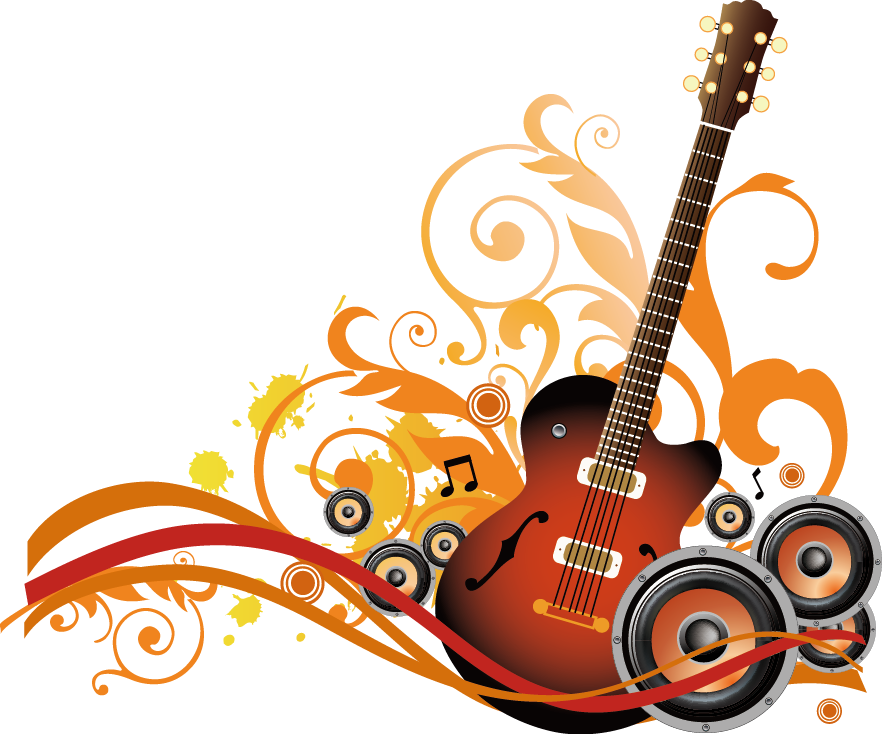PRS SE 245
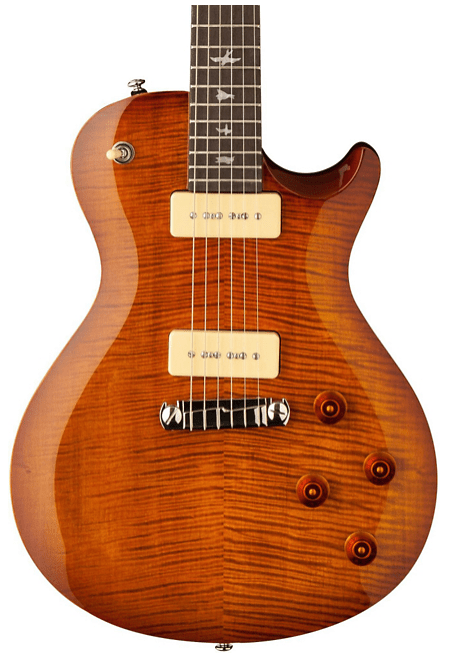
PRS SE 245 Electric Guitar Vintage Sunburst | Guitar Center
Get gig-ready with the classic tone of SE 245. Perfect for traditional single-cutaway players.
Check price
Check availability on Reverb
We may receive compensation from the companies whose products we review. We only recommend products that we believe in and test.
You can’t really write about alternatives to Les Paul models without including a singlecut PRS model, because of that time Gibson sued them over the similarities. The SE range is their affordable option, and the 245 borrows the Epiphone’s slab of mahogany with a maple veneer, albeit with a gorgeous flame.
The 245 also comes with PRS’s inimitable birds inlays. The lower horn includes some contouring to allow for more comfortable access to the higher frets. Apart from the stylistic differences mentioned, the electronics has an identical approach to the Gibson and Epiphone Les Paul models.
Epiphone Standard
Like the Gibson, the Epiphone version features a mahogany neck and a mahogany body with a maple top. However, the maple top on the Epi is thinner and does not have as much of an impact on the tone of the guitar. This is also one of the reasons an Epiphone Les Paul Standard is typically lighter than a Gibson.
For some players, that’s a good thing, but for others, it is an indication that this guitar isn’t quite there. A big reason a Gibson sounds so good lies in the woods used to build it.
As for pickups and electronics, the Standard features a set of Alnico Classic Humbuckers. These pickups aren’t bad, but as you’ll see below Epiphone has made some improvements in recent years.
The Epiphone Standard is a good guitar for a very good price. It’s reminiscent of what you’d expect from an Epiphone a few years ago in both its high value and its minor weak points.
It makes a great first «serious guitar» for beginners who have been playing a while, but can also serve as a solid instrument for veteran gigging musicians. There is a reason Epiphone is regarded as one of the top alternatives to the Gibson LP, and it all starts with the LP Standard.
Падения и взлеты
После Второй мировой войны мир изменился. Гитары Epiphone стали восприниматься как устаревшие инструменты. К тому же внезапно умирает Эпи, а его младшие братья ссорятся. Компания была на грани банкротства, когда пришло спасение. И откуда – из стана главных конкурентов. Фирма Gibson выкупила все производственные мощности Epiphone, сохранив марку для потомков.
Очень быстро гитары Epiphone вернули себе расположение музыкантов самого высокого уровня.
С расцветом фолк-музыки в 60-х гг. модели Seville, Madrid, Entrada и Espana стали безумно популярными среди исполнителей. В 1962 году была выпущена 12-струнная гитара Bard, на которой Рой Орбисон сочинил гениальную песню «Oh, Pretty Woman».
Epiphone Bard
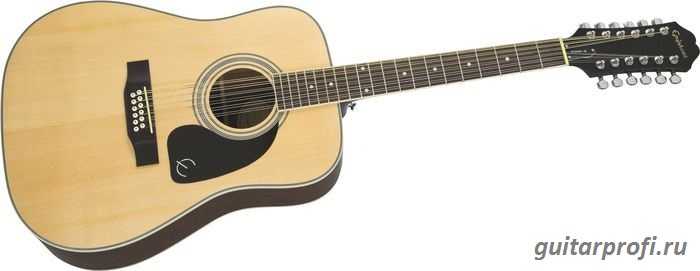
С гитарой Epiphone в руках в истории мировой музыки осталось множество великих исполнителей. Начать рассказ стоит с «битлов» – сначала Пол Маккартни, а затем и Джон Леннон с Джорджем Харрисом выбрали в качестве одного из своих основных инструментов гитару Epiphone. Модель Casino и вовсе стала широко известна как «гитара Леннона», хотя её использовали на концертах и для студийной записи другие участники группы. Все альбомы «The Beatles» от «Help!» до «Abbey Road» записаны с участием инструментов от компании Epiphone.
Современное состояние марки Epiphone
После «золотых» 60-х снова настали нелегкие времена. Лишь в 90-е годы, с переездом производства в Корею, компания смогла обрести твердую почву под ногами. Было возвращено производство легендарных моделей – Casino, Riviera, Sorrento. Известные музыканты начали заключать договоры о сотрудничестве с Epiphone: Честер Аткинс, Ноэл Галлахер из группы Oasis. Были также детально воссозданы модели Revolution Casino и John Lennon 1965, ставшие предметом охоты со стороны коллекционеров.
Современный модельный ряд гитар Epiphone включает в себя как акустические гитары, так и электрогитары таких, например, типов, как Les Paul, SG и другие.
Звучание гитары Epiphone EJ200CE
https://youtube.com/watch?v=lwfhRY92eV4
Среди современных исполнителей, использующих гитары Epiphone, можно выделить Ленни Кравица, группы Radoihead, My Chemical Romance, Machine Head и многих других.
Epiphone Les Paul Standard vs. PlusTop PRO
So you’ve read this far, and maybe the differences between the Standard and PlusTop PRO aren’t quite clear. Here’s a quick breakdown:
Similarities:
- Both are made with mahogany bodies and hand-set mahogany necks.
- Both guitars have rosewood fingerboards with block inlays and 22 frets.
- Both have locking Tune-o-matic bridges with stop bar and Grover tuners.
- They both weigh in at around 8.5 pounds. (This will vary slightly.)
Differences:
- The Standard has Alnico Classic humbuckers, where the PlusTop has upgraded ProBuckers with coil splits. For most players, this gives the edge to the PlusTop. The pickups on the Standard are not quite as hot and not quite as articulate.
- The PlusTop has a thin maple veneer you can see through the paint. This does not impact sound much, if at all.
- The Standard comes in basic, solid colors, whereas the PlusTop comes in nice burst finishes. It’s a matter of choice, and neither is better.
- The PlusTop is a more expensive guitar, typically to the tune of about $100, give or take.
The Epiphone Les Paul
Trying to choose between the Epiphone Les Paul Standard, Studio, PlusTop PRO and Custom PRO? Apparently so, or you wouldn’t be here! You’re not alone. This is a tough decision, and to make the right choice, you need all the facts.
First, you have the classic Epiphone Standard. This baby is modeled after the Gibson Les Paul, as you surely know. It’s got pure rock attitude and the sound to match.
The Epi Standard has come a long way in recent years, and the PlusTop PRO model now adds some improved features to this already great guitar. Many veteran musicians rely on it as a solid, budget-friendly alternative to Gibson.
Then you have the Epiphone Custom PRO. It’s slick, shiny and makes you feel like you ought to be wearing white gloves while you play it. This is truly an amazing-looking guitar, and whether you choose Ebony or Alpine White, you’re making a serious upgrade in appearance from the Standard PRO model for only a few bucks extra.
Finally, you have the Epiphone Studio. This is really a great guitar in this price range, and it has all the appointments you need to call it a real Les Paul. But it is much more of a bare-bones version, just like its Gibson counterpart. In fact, in my opinion, the Studio compares favorably to the Standard, but does that mean the same is true in the Epiphone lineup?
Let’s compare these awesome guitars and help you figure out which is the best choice for you.
Les Paul Custom PRO
The Epiphone Les Paul Custom is a prettied-up version of the LP Standard PRO. I’ll be honest: My dream guitar has always been a Gibson LP Custom, but there is simply no way I could ever justify the cost. If you feel the same way, the Epiphone LP Custom may be your ticket.
This is a gorgeous guitar, but beneath the surface, it is pretty much the same instrument as the LP Standard PRO. There’s a slight price difference, but the upgrade is aesthetic.
The Epiphone LP Custom PRO features the same mahogany body with maple top, mahogany neck, and rosewood fingerboard as the Standard PRO. And, it has the same great ProBucker pickups with coil tap.
Cosmetically, it has gold hardware instead of chrome, prettier inlays in the fingerboard, a cool Les Paul Custom inlay in a bound headstock, and black speeds knobs instead of the Gibson top hat knobs.
This guitar isn’t better or worse than the Standard PRO, just cosmetically different. If you like the look of the LP Custom, go for it!
The Studio
The Epi Les Paul Studio is a stripped-down version of the guitars listed above. This is a great electric guitar for serious beginners and very affordable. It lacks the maple top and features a carved mahogany body and mahogany neck with a rosewood fingerboard. It has Alnico Classic humbuckers like the Standard, but these are an open-coil design.
Open-coil humbuckers tend to be a little hotter and brighter than pickups with covers, and I think that works well in the context of this guitar.
There are no bindings or fancy inlays, and aside from the dots on the fingerboard instead of blocks, this guitar has the look of a Gibson LP Studio.
I happen to like that look a lot. I think if I were a beginner, or an intermediate guitarist looking to upgrade from a starter guitar, I’d be tempted to grab this LP.
This guitar isn’t in the same league as the Standard PRO and Custom PRO models above, but it might give the Standard a run for its money.
The point of the LP Studio is to give a player all the good things about a Les Paul without the fancy stuff that drives the price up. This guitar gets that done.
For low-intermediate players, those getting back to guitar after a long layoff and serious beginners it is a good option. There is also a Goth version with an evil-looking black paint job, in case you want to give the neighbors a little extra scare.
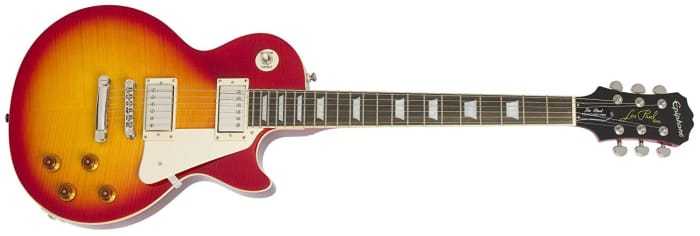
Epiphone Les Paul Standard PlusTop PRO
Сравнительная таблица
Все познается в сравнении, поэтому давайте сравним характеристики устройств. Сравнительная таблица наглядно покажет, какой прибор лучше по каким показателям.
| Модель | Цера (руб.) | Мензура («) | Количество струн | Материал корпуса | Материал грифа |
| Squier Affinity Telecaster | 15 000 | 25.5″ | 6 | ольха | клен, накладка: клен |
| Squier Affinity Stratocaster | 21 500 | 25.5″ | 6 | ольха | клен, накладка: палисандр или клен |
| Cort G110 | 9 000 | 25.5″ | 6 | агатис | клен, накладка: палисандр |
| YAMAHA Pacifica112V | 19 000 | 25.5″ | 6 | ольха | клен, накладка: палисандр |
| Fabio ST100 | 11 000 | 27.17″ | 6 | ольха | клен, накладка: палисандр |
| Epiphone Les Paul Studio | 22 500 | 24.75″ | 6 | тополь | махагони, накладка: палисандр |
| Cort CR100 | 31 000 | 24.75″» | 6 | красное дерево | клен, накладка: палисандр |
LP Standard PlusTop PRO
Not so long ago, when you bought an Epiphone LP Standard, you had the choice between a solid Ebony finish and a pretty flame top. They were basically the same guitar; only one was painted black so you couldn’t see the veneer beneath.
Now the field is separated. There is the Standard model (above) with solid tops, and the PlusTop PRO model, with gorgeous flame or quilt tops featuring burst and see-through finishes. There’s a significant price difference between the Standard and the Standard PRO, but it’s about more than appearances.
I had a chance to play an Epiphone LP Custom PRO a while back, a guitar very similar to the Standard PRO, and a couple of things struck me right away. First, this guitar was hefty. It felt like a Les Paul should, with a beefy neck and thick body. Epiphones always felt flimsier than Gibsons to me, but not in this case.
The second thing was the pickups. The LP Standard (and Custom) both feature Epiphone ProBucker pickups, and I think they are significantly better in clarity and warmth than the Alnico Classics. They also have a coil tap function, which is a cool but unexpected feature.
The Epiphone LP Standard PRO is a serious upgrade from the Standard, and in my opinion, shortens the gap between Epiphone and Gibson significantly.
There were always some pretty good reasons you’d choose Gibson over Epiphone, regardless of price. Those reasons start to make less sense when Epi puts out guitars like this. If you are a serious guitarist and you don’t want to spend a lot of cash, but you want a Les Paul, stop thinking so hard and grab one of these.
FAQs About the Epiphone Les Paul Standard
Question: Is the Epiphone Les Paul Standard Plustop Pro different than the Gibson Les Paul?
Answer: Yes, of course. The Epiphone is owned by Gibson, so the guitars are virtually the same (same mahogany body, solid maple top, mahogany neck, and rosewood frets), however, they are manufactured in a different place. The Epiphone is manufactured mostly in China and Indonesia, whereas the Gibson is manufactured in Korea and the USA.
Question: Does the Epiphone Les Paul come with a professional setup?
Answer: This depends on the place of purchase. Some stores including online ratailers sell already setup guitars, but it doesn’t necessarily mean that you will get one ready to play.
Question: Does the Epiphone Les Paul Standard Plustop Pro come with any additional details?
Answer: No. If you buy it from a music store you might be able to make a deal with the seller to get an extra accessory for the guitar, otherwise, it does not come with a case or picks.
Epiphone: Top Picks
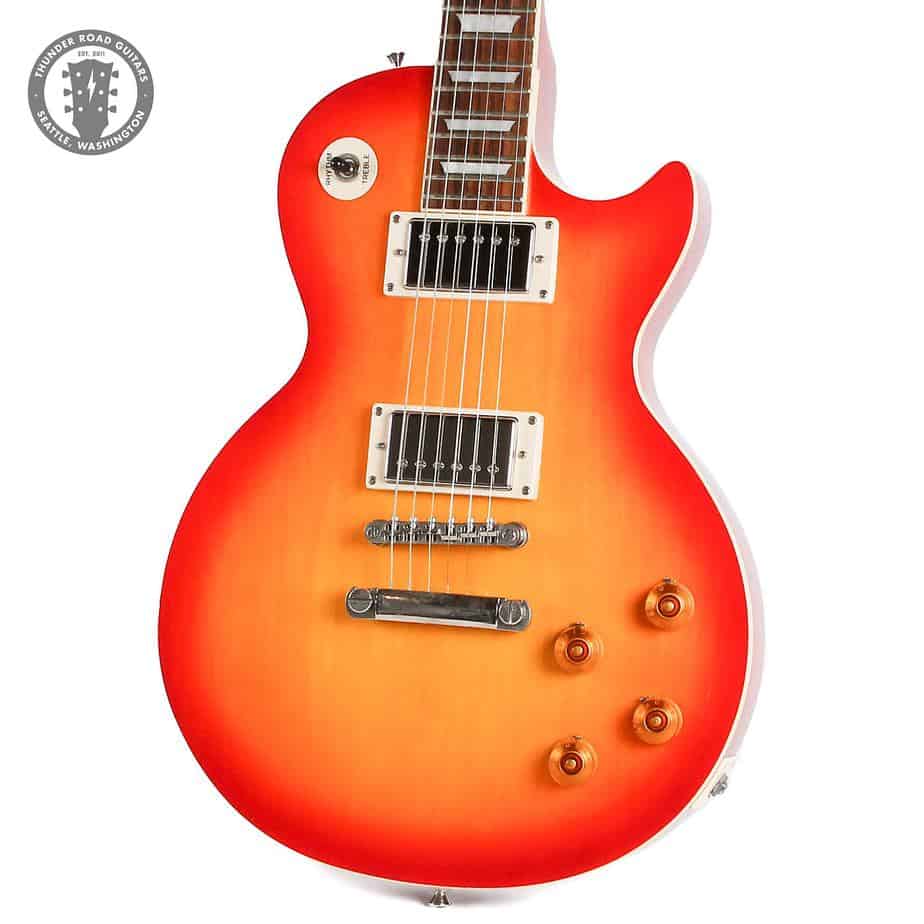
Epiphone 1960 Tribute Black Cherry | Reverb
You’ll never regret buying this used Epiphone 1960 Tribute Plus in its original cherry sunburst finish, in excellent condition from Reverb. An owner of this guitar rated this as «the best sounding and playing guitar Epiphone has made.»
Check price
We may receive compensation from the companies whose products we review. We only recommend products that we believe in and test.
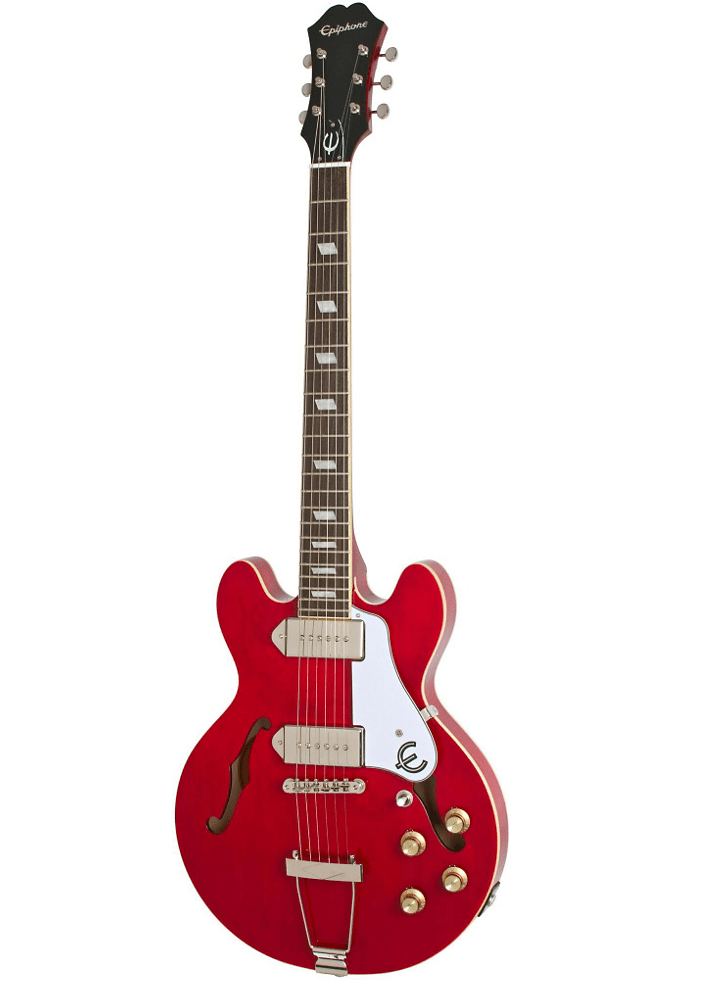
Epiphone Casino Coupe Hollowbody Electric Guitar | Sweetwater
The Casino Coupe is the iconic hollowbody Casino reborn in a smaller, comfortable ES-339 body size.
Check price
Buy at SamAsh
We may receive compensation from the companies whose products we review. We only recommend products that we believe in and test.
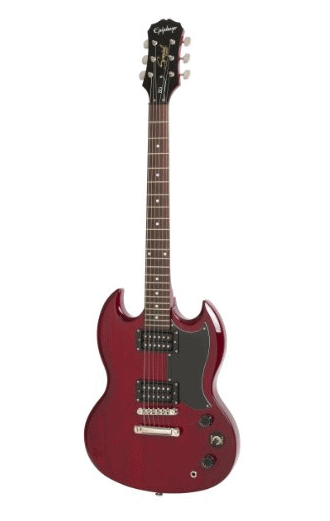
Epiphone Limited Edition 1966 G-400 PRO Electric Guitar | Amazon
This offers players unlimited sound and style without the vintage price tag. It has a deep double-cutaway body to let you reach all 22 frets with ease.
Buy at Amazon.com
Check availability on Reverb
We may receive compensation from the companies whose products we review. We only recommend products that we believe in and test.
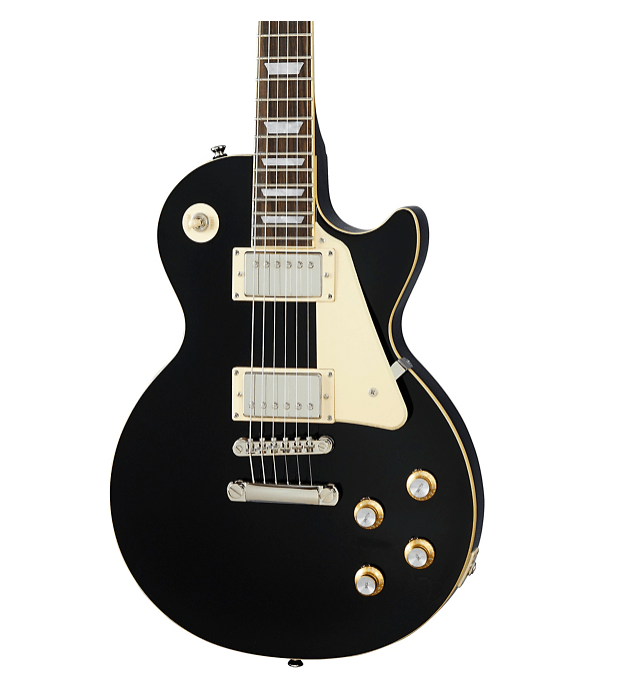
Epiphone Les Paul Standard ’60s Electric Guitar | Guitar Center
This Epiphone Les Paul Standard ’60s brims with vintage character and legendary rock ‘n’ roll vibe. Its resonant mahogany body is harmonically rich, and the maple top is full of clarity, punch, and snap.
Check price
Check availability on Reverb
We may receive compensation from the companies whose products we review. We only recommend products that we believe in and test.

Epiphone DR-100 Acoustic Guitar | Guitar Center
The DR-100 has long been Epiphone’s best-selling acoustic guitar and has the look, sound, and build quality that first time players and professionals expect when choosing an Epiphone.
Check price
Check availability on Reverb
We may receive compensation from the companies whose products we review. We only recommend products that we believe in and test.
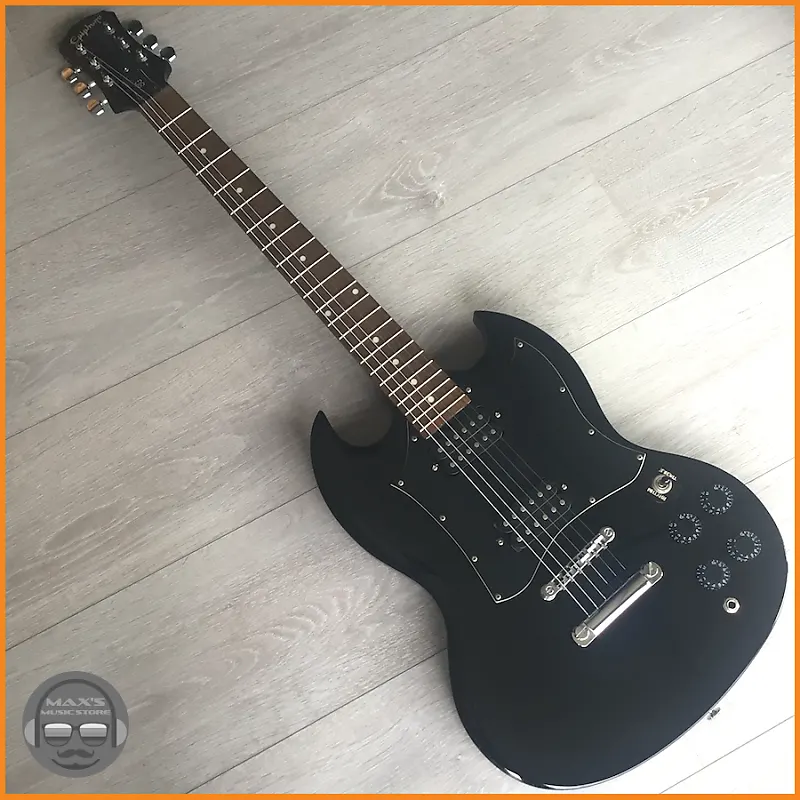
Epiphone G-310 SG Ebony | Reverb
The Epiphone G-310 solid-body electric guitar gives you all the style and sound of the venerable SG at a down-to-earth price.
Quick tip: If an item is currently not available on Reverb, you can select ‘Follow this product’ to be notified of any new listings.
Check price
Buy at Amazon.com
We may receive compensation from the companies whose products we review. We only recommend products that we believe in and test.
Recommended Reads:
- Epiphone LP Special II Review You’ll Love
- Epiphone Les Paul Electric vs Squier Stratocaster Comp
- The Full, Epic Epiphone Les Paul Standard Review
- Humbucker Pickups vs Single Coil: Which is Best for You?
- How to find the Best Electric Guitar
Best Epiphone Les Pauls: Buying advice
(Image credit: Future)
The 2021 Epiphone lineup is split into two categories: Original and Inspired By Gibson. As the name implies, the Original category is populated by Epiphone designs that you won’t find anywhere else – i.e. on the Gibson website. You’ll find guitars such as the Casino, the Wiltshire and the Coronet in there, and it really is quite thrilling to see some of these back in production with fresh finishes and updated spec.
The Inspired By Gibson models are, by some distance, a larger collection, and this is where the ES models, the SG, the Flying V, the Explorer, the Firebird and – of course – the Les Paul are listed. These designs have been with us since the 1950s and early ’60s. Modernizing a collection such as this is not easy when there’s a brand heritage to be maintained, but looking at Epiphone’s lineup versus Gibson, there’s clearly a little more room for maneuver.
We see that in the Prophecy series, which aggressively appropriates Gibson’s Flying V, Les Paul and Explorer, and weaponizes them with active, multi-voiced Fishman Fluence humbuckers. They are perfect for metal, and even have a little visual flair with the abalone/MOP block fingerboard inlay and split-diamond on the headstock.
The most forward-thinking design in both the Gibson and Epiphone collections is the newly configured Les Paul Modern. From the front, it looks like a regular Les Paul Standard with some jazzy crystal-clear control knobs and a finish that recalls Gibson’s late-’60s adventures in solid metallic colors. Yet turn it around and you’ll find a contoured heel to enhance upper-fret access. Also, under the surface, the guitar’s body has a number of cavities in it to reduce weight, along with a control circuit with push-pull functions to activate a P-90 mode when required. It’s pretty nifty, not straying too far from the original vision while offering some mod cons that today’s player might appreciate.
You might expect the two brands to be rigidly aligned when it comes to finish options, but here, Epiphone has a little more scope to experiment, offering the Les Paul Modern Figured in some unorthodox bursts that might just catch the eye of anyone tiring of the same old.
(Image credit: Future)
Epiphone: A beginner’s guitar?
Epiphone might be more affordable across the board than its parent company, but we shouldn’t typecast it as an entry-level brand. Just look at the 1959 Les Paul Standard Outfit – spec’d in the first collaboration between Epiphone and the Gibson Custom Shop, it’s a serious guitar at a reasonable but by no means cheap price.
The strategy seems clear: keep innovating at the top end of the range, adding better pickups and components, while scaling-down the spec for beginner models. After all, beginners can’t be spending 500 dollars on a guitar. The biggest differences you’ll find between the top-line Epiphone models and its most basic builds are that the entry-level models typically use bolt-on necks as opposed to the glued-in necks found on the rest of the range. The pickups and components are not quite of the same standard. No one would expect them to be.
As for the fundamental differences in build between a US-built Gibson and a Chinese-built top-of-the-line Epiphone? Besides the headstock, Epiphone fingerboards are made of Indian laurel while the US Gibsons are fashioned out of rosewood. On the Epiphone Les Pauls, you’ll find a maple veneer, while on Gibson models it’s a thicker cap that naturally imparts more influence on the tone of the instrument.
Though their histories and fortunes are inextricably linked, there will always be a little distance between the two brands. However, that gap is closing, and right now we would happily gig a high-end Epiphone Les Paul. The components, build, tone, feel and sustain make a compelling case.
Find out more about how we make our recommendations and how we test each of the products in our buyer’s guides.
ESP LTD EC-401
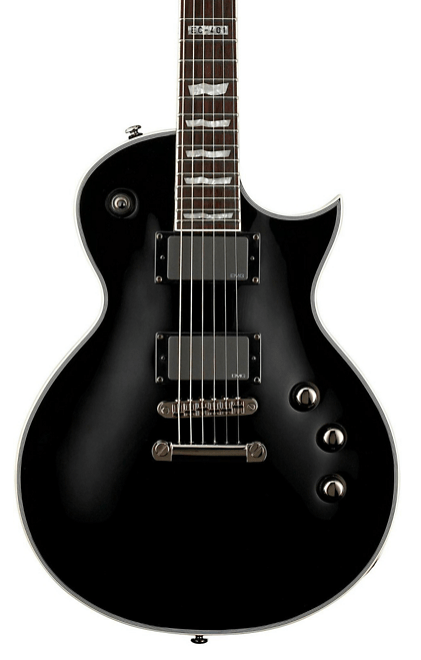
ESP LTD EC-401 Electric Guitar | Guitar Center
4.8
Look no further with this as it features versatile, powerful tones, reliable hardware, and tidy, attractive looks. Plus consistent high rating from the people who’ve purchased this.
Check price
Buy at Amazon.com
We may receive compensation from the companies whose products we review. We only recommend products that we believe in and test.
For something a little different, but in the same vein – perhaps leaning a bit more towards metal – the longstanding and very respectable ESP have the EC-401 Eclipse model from their LTD range.
This one is probably closer to the Gibson, in that the body is a slab of mahogany. What might lean it towards metal brothers and sisters are the inclusion of EMG active pickups. It has binding around the body and mahogany neck, its hardware is black, and the inlays on the fingerboard are reminiscent of a waving flag.
The Final Note
The Epiphone Les Paul Standard is such a go-to guitar for those looking to make the transition from “learner” to “player,” at least just to look at and consider.
If a guitarist is experienced enough to be considering it, they’ll be experienced enough to that you get what you pay for. No, this won’t have the finery of a Gibson Les Paul but that’s not why these guitars are made.

Epiphone 1959 Les Paul Standard Outfit Electric Guitar | Guitar Center
The Epiphone 1959 Les Paul Standard comes beautifully bound with an aged gloss finish. It’ll arrive ready to play and includes a nice hardshell «Lifton» style case with pink interior and tan tolex.
Check price
Check availability on Reverb
We may receive compensation from the companies whose products we review. We only recommend products that we believe in and test.
Questions & Answers
Question: Is the Epiphone Les Paul capable of a rich, deep, clean sound similar to Carlos Santana’s tone on Samba Pa Ti?
Answer: Yes. Like its Gibson namesake, the Epiphone version of the Les Paul is known for its warm, rich tone and it sounds great clean or with just a touch of overdrive. In other words, the types of sounds Santana is known for. A guitar player on a budget can get that same kind of smooth, buttery tone with something like an Epiphone Les Paul PlusTop PRO. However, I will add a few cautions here.
First, there are many guitars we could say this about. Since the early ‘80s, Santana has played PRS guitars, and something like a PRS SE Custom 22 could get the job done as well. Really, anything with a mahogany body and neck and moderate-output humbuckers will get you in the neighborhood of Santana sound. Use the neck pickup, and experiment with rolling back the tone control.
Second, it’s a fool’s errand to chase legendary tone on a budget, and not much easier with limitless cash at your disposal. Back when Santana recorded Abraxas he was playing Gibson guitars, sometimes with P-90 pickups and sometimes not. So, what guitar did he use on Samba Pa Ti? Does it really matter?
It’s the same with any guitar hero. We could argue and speculate endlessly about the gear they used on a certain song or album, and then spend a huge amount of time and money trying to replicate it ourselves. This is the path to madness. For the sake of discussion, it is entertaining. But, for the sake of putting together a guitar setup that sounds great and doesn’t kill your budget, it isn’t really helpful.
I think it is far more important to understand the characteristics of the sound you want and get your tone “in the neighborhood.” In this case, an Epiphone can certainly help you with that.
Which Guitar?
It seems two distinct classes of Epiphone Les Pauls revealed themselves throughout this review. There’s the PRO Les Paul. These are among the best electric guitars for intermediate players, but even professional musicians can make use of them in recording and gigging situations.
While the Epiphone has always been a good alternative to Gibson, I think the gap is closer than ever with the Standard PRO and Custom PRO.
Then there’s a class for intermediate players or musicians looking for their first good guitar. The Standard and Studio are both great values too, but professional musicians probably would have to make a few upgrades to find them useful. However, they’re perfect for younger players and serious beginners.
My choice? I’d go with the Custom PRO in Alpine White, but I really love the sunburst finishes on the Standard PlusTop PRO too. I think I might need one of each of those in the not-too-distant future.
But the choice is yours. Which guitar have you decided is right for you?
Les Paul Custom Special Studio
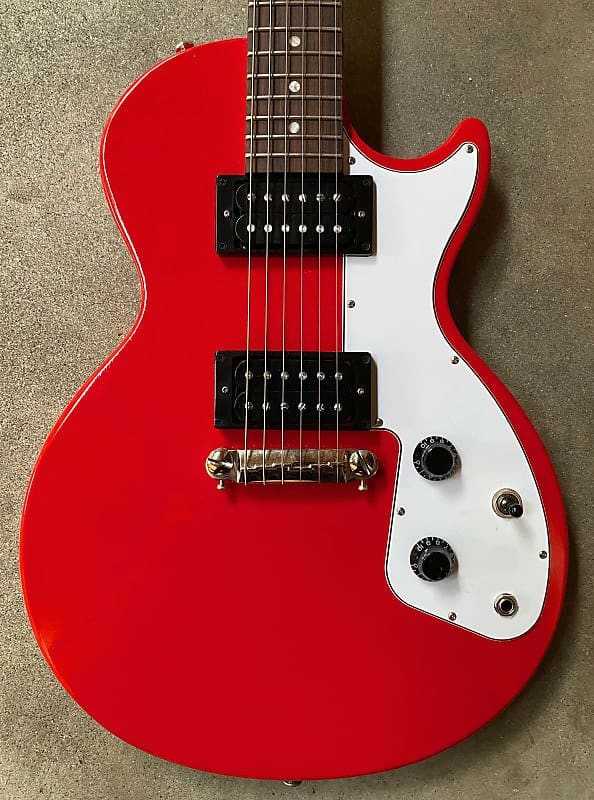
2017 Gibson S Series Les Paul M2 Bright Cherry Electric | Reverb
This was designed around Gibson’s standards of quality and innovation for Gibson USA’s new S Series. The Gibson S Series is a whole new range of guitars all made in the US, but at a considerably lower price point than ever before.
Check price
We may receive compensation from the companies whose products we review. We only recommend products that we believe in and test.
From the S Series, comes the Les Paul Custom Special Studio, with the same MSRP as the Epiphone Les Paul Standard. Ultimately, it comes down to whether you want a cheap Gibson, or an expensive Epiphone. In terms of build quality, they really are neck and neck, if you’ll pardon the pun.
This is a no-frills affair, with the embellishment really just the range and brightness of the finishes. It’s very much the quintessential “slab of mahogany with a couple of humbuckers wedged in.” Check out our full custom vs standard Les Paul comparison.
